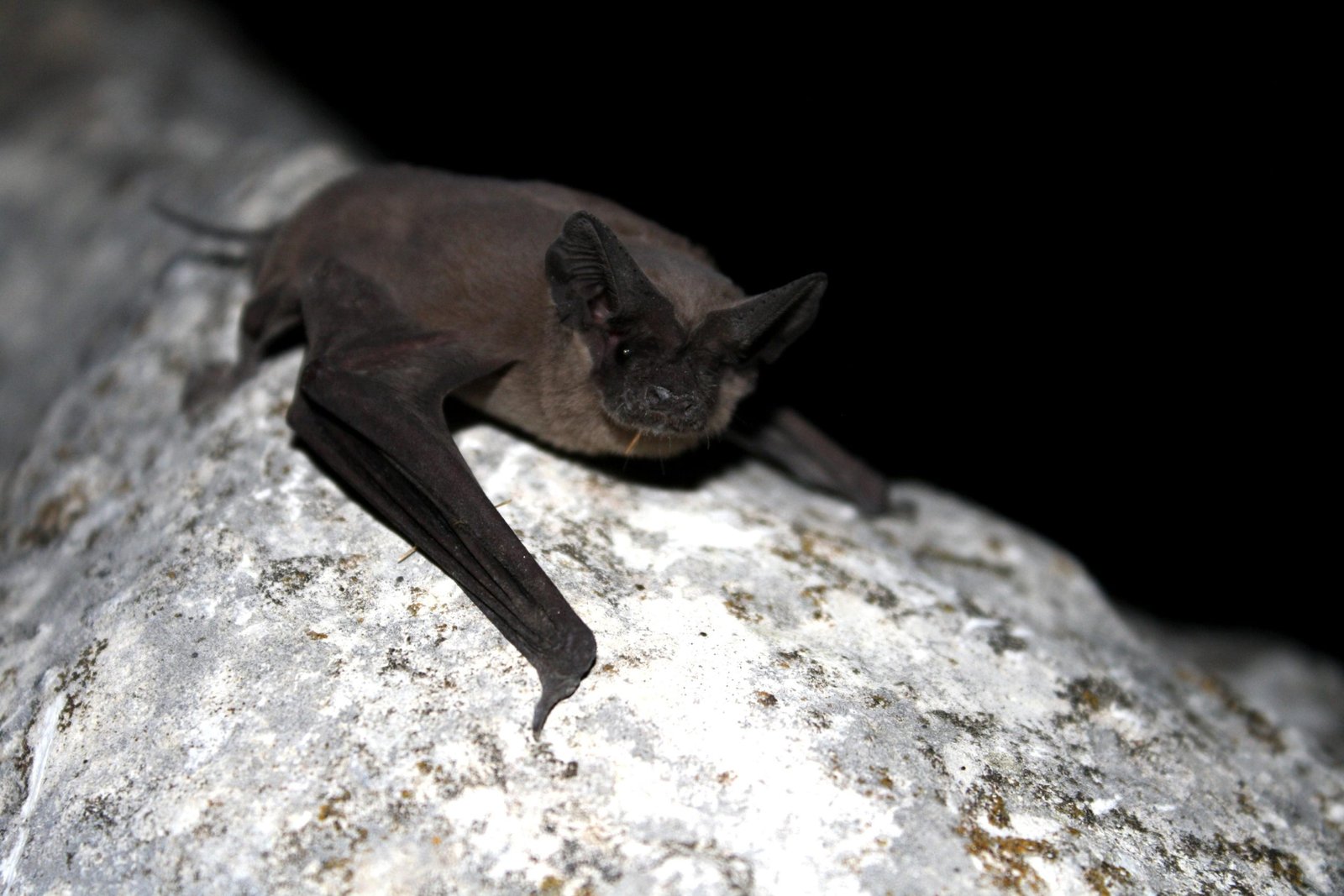Big Free-Tailed Bat: Nyctinomops Macrotis

The big free-tailed bat is apart of the Molossidae bat family. This species can be by its long narrow wing membrane and it’s dark red or brown coat.
Roosting sites of this bat are typically high in the air because the bat must gain speed while flying to achieve flight. Desert rock crevices are frequently where this bat will roost.
Learn More: Desert Bat Species
Characteristics Of The Big Free-Tailed Bat
Adult males of this species range from 145-160 mm in head-body length, while females are smaller (120-139 mm).
The Nyctinomops macrotis coat is glossy and velvety to the touch, seemingly almost greasy. The coat is bi-colored, dark red dorsally to dark brown, and substantially lighter ventrally.
The wings are narrow and long, and the wing membrane is thin and leathery. Somewhere between 40 and 52 mm behind the small tail membrane, the tail extends freely. Nyctinomops macrotis’ face is black; on top of the head, the ears lay forward and are joined at their bases; the muzzle is relatively thin, and the upper lip is very furrowed. The legs are short and very strong in Nyctinomops macrotis. 1Go To Source animaldiversity.org -“Nyctinomops macrotis big free-tailed bat”
Big Free-Tailed Bat Behavior
Big free-tailed bats roost in crevices high on cliff faces in their typical habitats in the Southwest. The roosting sites’ height allows the bat to fall and gain speed to provide a flight lift. This is necessary because, in the United States, big free-tailed bats have the narrowest, longest wings of any bat. With these long, narrow wings, maneuverability is not needed in areas where they are adapted for fast, enduring flight. Late in the evening, this bat forages, occasionally emitting a sharp, piercing call.
This bat forages late at night but is sometimes seen flying early in the afternoon. Its flight is straight and quick, and as it flies overhead, its wings’ noise is occasionally audible. While foraging, it often emits a sharp, piercing call. 2Go To Source webapps.fhsu.edu -“BIG FREE-TAILED BAT Nyctinomops macrotis (Gray, 1839)”
Reproduction Cycle Of The Big Free-Tailed Bat Species
In midwinter, breeding probably takes place while the species is at warmer latitudes. A single youngster was born between mid-June and early July. Females form nursery colonies, and until they are nearly full-grown, the young do not leave the nursery. 3Go To Source us-parks.com -“BIG FREE-TAILED BAT”
Big Free-Tailed Bat Habitat

This bat frequents areas of rocks or canyons where it roosts in crevices. This migratory species is a rapid, powerful flier, and as far north as Canada, occasional individuals wander. There is little knowledge of mortality and longevity. 4Go To Source cnhp.colostate.edu -“Big free-tailed bat (Nyctinomops macrotis)”
Big Free-Tailed Bat Range
N. Macrotis has been recorded in Mexico, Arizona, New Mexico, Texas, southern California, southeastern Nevada, southern Utah, and north to central Colorado.
The species is migratory, and some extra-limitary records are available from British Columbia, Kansas, Iowa, and South Carolina. Big Free-Tailed Bats typically live at an elevation from sea level to 8,500 ft. In arid landscapes, N. macrotis appears to be primarily an inhabitant of rough, rocky habitats. Several plant associations, including desert shrubs, woodlands, and evergreen forests, have been found. Research shows this species is found near lowland but also have been spotted at 8,000 ft above sea level in Mexico. 5Go To Source tpwd.texas.gov -“Big Free-tailed Bat (Nyctinomops macrotis)”
Diet Of The Big Free-Tailed Bat
Free-tail bats eat vast quantities of moths and other insects. It is known that some roosts contain millions of bats. A single colony may eat an estimated 250 tons of insects each night. 6Go To Source desertmuseum.org -” Animal Fact Sheet: Mexican Free-tailed Bat”
Threats To The Big Free-Tailed Bat Species
To date, no known threats to the species have been recognized. However, for big free-tailed bats, some of the general threats to bats could apply. These could include impacts from grazing, riparian management, pesticides, and disturbance of the roost site in some places to foraging areas. Still, most roosts are likely not vulnerable to such impacts.
In arid regions, the availability of large, obstacle-free drinking sites may limit the number of bats. Compared to the historical situation, such sites have decreased in number, and ongoing climate change could increase this threat. Pesticide broadcasting could have direct or indirect impacts, but the effects are uncertain. 7Go To Source fs.usda.gov -“Species: Big Free-tailed Bat (Nyctinomops macrotis)”
Sources:
- Lawrence, J. 2002. “Nyctinomops macrotis” (On-line), Animal Diversity Web. Accessed January 12, 2021 at https://animaldiversity.org/accounts/Nyctinomops_macrotis/
- Sternberg Museum of Natural History. “Kansas Mammal Atlas: Big Free-Tailed Bat.” Kansas Mammal Atlas, Fort Hays State University, 13 July 2017, webapps.fhsu.edu/ksmammal/account.aspx?o=32&t=183.
- U.S. Parks. “Big Free-Tailed Bat.” US-Parks.Com, US National Parks Travel Guide and Road Trip Planning, www.us-parks.com/nature-and-wildlife/mammals/big-free-tailed-bat.html. Accessed 12 Jan. 2021.
- “Big Free-Tailed Bat (Nyctinomops Macrotis).” Colorado Bat Working Group, Colorado State University, cnhp.colostate.edu/cbwg/bat-list/speciesprofile/?speciesID=18. Accessed 12 Jan. 2021.
- TPWD. “Big Free-Tailed Bat (Nyctinomops Macrotis).” Texas Parks & Wildlife, Texas Parks and Wildlife Department, tpwd.texas.gov/huntwild/wild/species/bigfreetail. Accessed 12 Jan. 2021.
- “Mexican Free-Tailed Bat Fact Sheet.” Arizona-Sonora Desert Musem, www.desertmuseum.org/kids/bats/mexican_free_tailed_bat.php. Accessed 12 Jan. 2021.
- “Species: Big Free-Tailed Bat (Nyctinomops Macrotis).” U.S. Forest Service, www.fs.usda.gov/Internet/FSE_DOCUMENTS/fseprd534281.pdf. Accessed 12 Jan. 2021.
